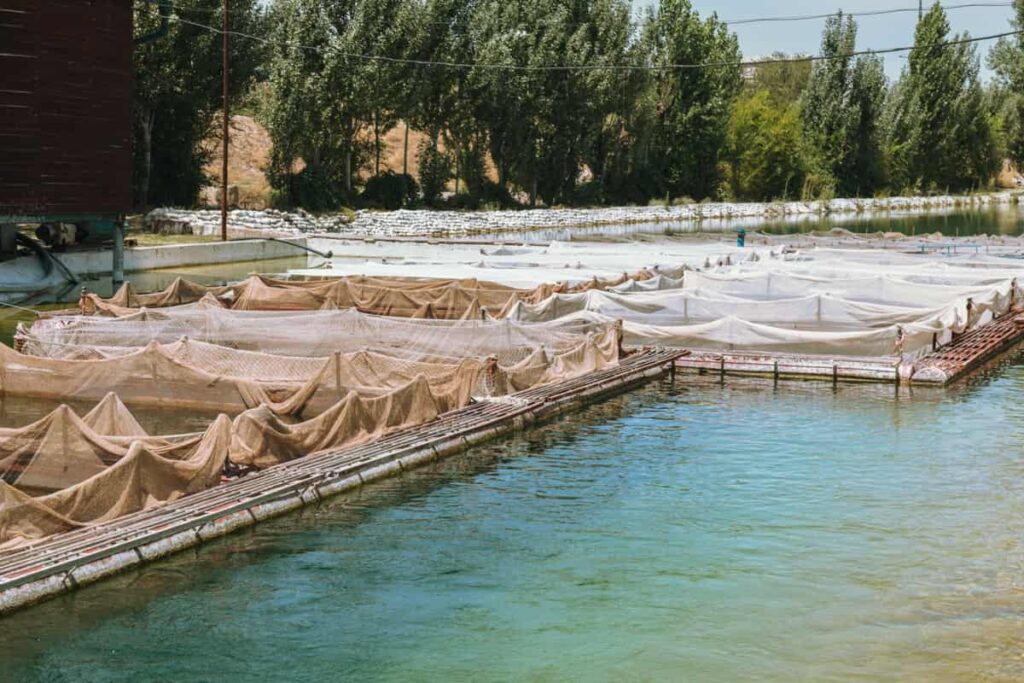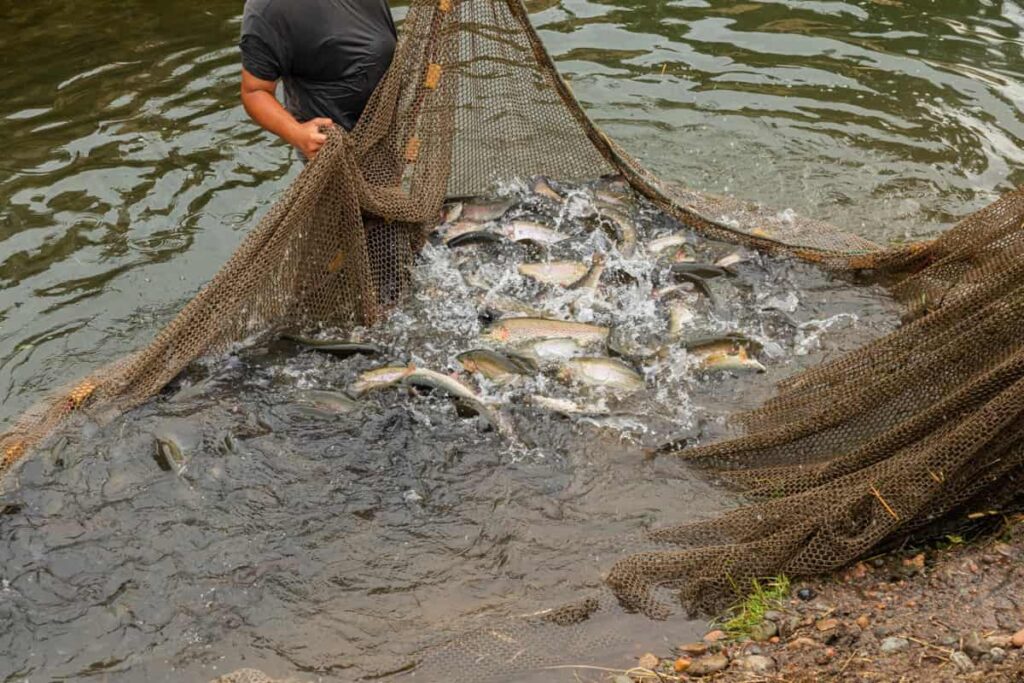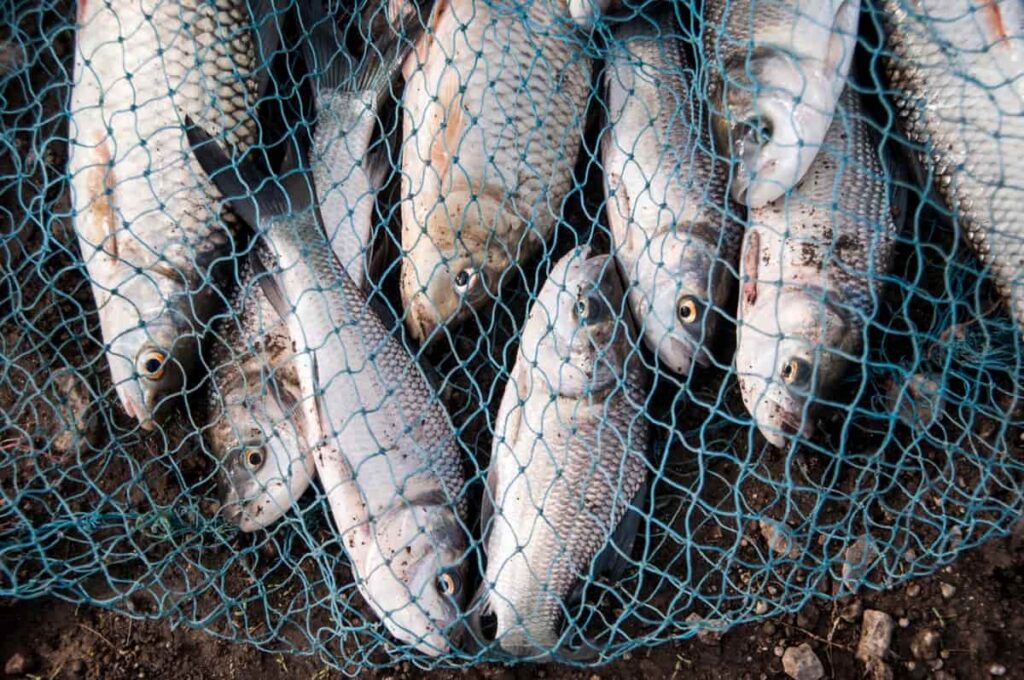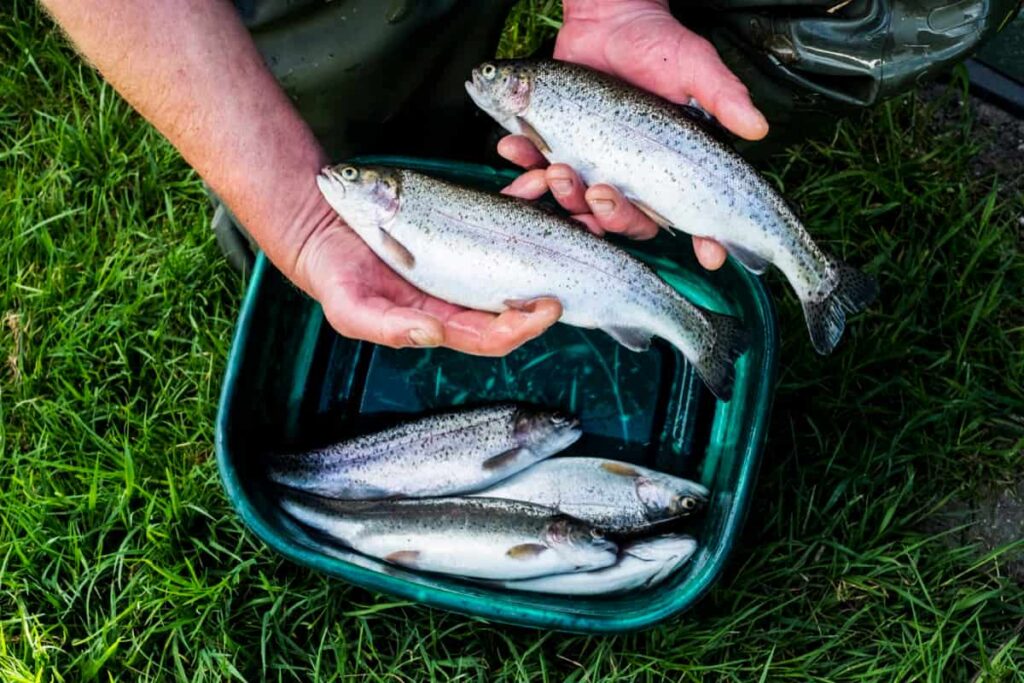Sustainable fish farming is becoming increasingly important as the global demand for seafood rises. However, traditional fish farming practices can have negative environmental impacts, including water pollution and depletion of wild fish stocks for use as feed. Zero-waste fish farming is a more sustainable approach that aims to eliminate waste and reduce environmental impact while increasing production efficiency.

Sustainable Fish Farming
Zero-waste Fish Farming
Zero-waste fish farming techniques include closed-loop aquaponics systems, integrated multi-trophic aquaculture (IMTA), selective breeding and biotechnology, and recycling and reusing fish waste. These practices have numerous benefits, including cost savings, improved fish health and welfare, and reduced environmental impact. However, there are challenges to implementing zero-waste fish farming, including managing nutrient levels in aquaponic systems and regulatory limitations.
Despite these challenges, successful zero-waste fish farms have been established worldwide, including Kampachi Farms in Hawaii and Sogn Aqua in Norway. The future of sustainable fish farming looks promising, with continued research and development of new technologies and techniques, as well as policy changes to support sustainable practices.
What is Sustainable Fish Farming?
- Sustainable fish farming is an eco-friendly way of farming fish that replenishes fish stocks without harming the environment. It involves cultivating fish in a healthy environment, avoiding chemicals and antibiotics, and growing fish naturally without artificial means to expedite growth.
- Sustainable fish farms minimize the environmental impact of more intensive farming processes, such as removing large quantities of water from natural reservoirs or lakes and introducing chemicals that can harm nearby ecosystems.
- Sustainable fish farms also manage fish waste sustainably, recycling and reusing it with environmental care. In addition to fish, sustainable aquaculture includes other marine life, such as mollusks, shellfish, and seaweed.
- However, there is a fine line between sustainable farming practices and those that are not, and it’s important to ensure that fish are grown sustainably and healthily.
In case you missed it: Fish Hatchery Business Plan: How to Start, Cost, Profits, and a Great Way to Make Money

How to Make Fish Farming More Sustainable
- Sustainable fish farming can be achieved by keeping fish healthy, being water-wise, reducing waste, and using land-based fish farms. Sustainable fish farms ensure the fish remain healthy by avoiding chemicals, additives, hormones, or antibiotics.
- They also use natural food stocks with the right balance of nutrients to ensure fish grow naturally. Sustainable fish farms are also water-wise by actively monitoring water quality and using a small surface area to prevent fish from forcing out native fish.
- Moreover, sustainable fish farms reduce waste by using as much of the fish as possible, preventing parts that would otherwise go to waste from needing to be disposed of.
- They also use land-based fish farms, which are particularly useful in managing demand in urban areas. Some fish farms are heading to the open ocean, where cleaner water and predictable water flows help reduce pests and waste, increasing sustainability.
Importance of Zero Waste Fish Farming Practices
- Zero-waste fish farming practices are essential to ensure the sustainability of the fish farming industry. This approach aims to minimize waste production, reduce resource consumption, and promote circularity by repurposing waste streams into valuable products.
- One of the significant benefits of zero-waste fish farming is reducing the negative environmental impact caused by conventional fish farming.
- By minimizing waste and reducing the use of chemicals and antibiotics, sustainable fish farms can create a healthy environment for fish growth, minimize water pollution, and preserve aquatic biodiversity.
- Moreover, zero-waste fish farming practices can lead to cost savings and new revenue streams. For example, waste products can be turned into fertilizer or animal feed, reducing the need for costly inputs while generating additional revenue.
The Different Types of Sustainable Fish Farms
- Sustainable fish farming ponds: These fish farms limit environmental impacts by ensuring that fish remain healthy without using chemicals, additives, hormones, or antibiotics. They use natural food stocks to ensure that fish grow naturally.
- Land-based farms: These farms contain chemicals and waste as fish are grown on land through tanks and filtration. However, they require a healthy natural habitat to recreate, and powering all the machines involved may have an environmental overhead.
- Bottom or Off-bottom culture: Fish farmers use natural habitats in the bottom or off-bottom culture fish farms and grow shellfish like oysters or mussels. They use large trays to grow them on the seabed or floating mesh nets.
- Open-ocean farms: These farms are becoming more popular for large-scale farming practices and have plenty of space to grow fish. They provide a specific level of sustainability by having clean water, which is healthier for the fish, and natural currents that wash away pests and waste.
In case you missed it: How to Start Polyculture Fish Farming In India: Composite Fish Culture, Mixed Fish Farming Examples, Benefits, and Disadvantages

Benefits of Zero Waste Fish Farming
- Environmental sustainability: Zero-waste fish farming significantly reduces the amount of waste and pollution released into the environment, making it more environmentally sustainable.
- Increased profitability: By using waste products for other purposes, such as fertilizer, animal feed, or biofuel, zero-waste fish farming can increase profitability for fish farmers.
- Improved fish health: By reducing the amount of waste in fish farms, the risk of diseases and infections in fish is reduced, leading to healthier fish and potentially increased yields.
- Diversified income: Zero-waste fish farming allows for additional income streams, as waste products can produce other valuable goods such as fertilizer or animal feed.
- Improved reputation: By implementing zero waste practices, fish farms can improve their reputation and appeal to consumers who prioritize sustainability and environmentally-friendly practices.
Zero Waste Fish Farming Techniques
- Integrated Multi-Trophic Aquaculture (IMTA): IMTA involves growing different species to benefit from the other’s waste. For example, fish can be grown alongside seaweed and shellfish, using excess nutrients from fish waste.
- Recirculating Aquaculture Systems (RAS): RAS use a closed system to recycle water, meaning water is treated and reused rather than discharged. This reduces water use and minimizes the release of nutrients and other waste into the environment.
- Biofloc technology: Biofloc technology involves using microbes to break down waste into a form that fish can reuse. This can reduce the amount of waste that needs to be disposed of and can also reduce water use.
- Vermicomposting: Vermicomposting involves using worms to break down organic waste, such as fish waste, into a nutrient-rich compost as fertilizer.
Sustainability in Fish Farming
- Microalgae create omega-3 fatty acids, and herbivorous and foraging fish consume the microalgae. Forage fish are eaten by predatory fish such as salmon and sea bass, and fishmeal and fish oil make up 30 to 50% of the fish feed typically used for these species. Over half of the world’s fish oil is used in the farmed salmon diet.
- Fish waste and leftover food spill into the water from nets, creating nutrient pollution. Antibiotics and pesticides on farmed fish can impact other marine species and human health.
- Closed systems on land reduce the amount of waste and nutrients released into the environment, eradicate fish escapes, and restrict disease spread.
- To produce the soybeans used in herbivorous and other fish feed, vast areas of South America are razed and converted to agricultural land yearly, amounting to nearly 4 million hectares.
- Shrimp cultivation has wiped out 38% of the world’s mangroves. Shrimp ponds accumulate shrimp waste, antibiotics, and pesticides, ultimately rendering them unusable without mangroves.
In case you missed it: Contract Fish Farming in India: Companies, Agreement, Profits, Process, Benefits, and Risks

Challenges in Zero Waste Fish Farming
- Zero-waste fish farming faces several challenges, including disease management, high water quality, energy use, cost, and regulatory compliance.
- Disease management protocols are crucial to prevent and control outbreaks due to high stocking densities and closed systems. Maintaining high water quality is essential for fish health, but it can be challenging in closed systems where waste buildup and other factors can cause poor water quality.
- Zero-waste fish farming requires significant energy, particularly for water circulation and filtration. The initial cost of setting up a zero-waste fish farm can be high, and ongoing costs can also be significant.
- Compliance with regulatory requirements, such as environmental and water use permits, is necessary to meet legal standards.
Sustainable Feed for Zero Waste Fish Farming
- Kampachi Farm tested fish diets supplemented with soybeans, plant waste, microalgae, and yeast products, with three feeds containing no fishmeal found to be comparable to the standard diet.
- Researchers at the University of Maryland developed fish feed made entirely with corn, wheat, and soy, replacing fish oil with fatty acids from algae, amino acids, and soybean or canola oil, resulting in fish with 100 times lower levels of PCB and mercury than those eating fishmeal feed.
- British scientists genetically modified camelina sativa to produce omega-3s that successfully replaced fish oil in fish feed, with the salmon thriving.
- A Texas A&M University scientist substituted sorghum and corn distillers’ dried grains for 10 percent of the protein in shrimp feed, using distillers’ dried grains with solubles as a cheap source of protein.
- Calysta is developing protein for the feed using bacteria that are fermented and fed methane gas, creating FeedKind, a natural, high-quality protein fishmeal replacement.
- Researchers from Wageningen University in the Netherlands are experimenting with insects as a new source of omega-3 fatty acids, with a 2014 FAO paper concluding that insect meal could replace up to 100 percent of fishmeal or soymeal in fish diets with no adverse effects.
- According to a Stanford University study, using the waste from seafood processing plants and adding algae or ethanol yeast to boost the protein content could replace half to two-thirds of the current fishmeal used in Chinese aquaculture.
- The lowest feed conversion ratio is important, with tilapia requiring less than a pound of food to produce protein, while salmon require a pound and a half. Proper farming practices and nutrient-rich food are essential to achieve the lowest conversion ratio.
In case you missed it: Contract Fish Farming in India: Companies, Agreement, Profits, Process, Benefits, and Risks

Management Tips in Zero Waste Fish Farming
- Collect and analyze data to determine where the loss occurs, what kinds of loss occur, and what causes the loss. For example, the Food Loss and Waste Protocol can assist in quantifying and reporting on food loss and waste by providing a standardized approach and best practices to close data gaps.
- Improve operational efficiency to minimize losses through improved processing efficiency and better cold chain management, which keeps the seafood fresh. Upgrades to fish processing operations require resources or capacity, but the expenditure pays off.
- Create new products using byproducts, like fishmeal, fish oil, fertilizers, supplements, and circular economy thinking to drive innovative uses for byproducts, like fish skin wallets, sports drinks, cosmetics, and biofuel.
- Build demand for under-utilized fish parts by educating consumers about their nutritional value and ways to prepare them. Collaboration between civil society organizations, social media influencers, and creative chefs can help promote dishes made with less conventional seafood.
Zero Waste Fish Farming Practices
- Aquaponics: Combining fish farming with hydroponic vegetable cultivation to create a closed-loop system where the waste from the fish is used to fertilize the plants.
- Integrated Multi-Trophic Aquaculture (IMTA): Cultivating multiple species in one system to create more efficient use of resources, with waste from one species serving as food for another.
- Biofiltration: Using microorganisms to break down fish waste and convert it into nutrients that can be used to fertilize crops.
- Water recirculation: Using a closed-loop water circulation system to conserve water and reduce waste.
- Selective breeding: Breeding fish with a high tolerance for waste and low disease susceptibility.
- Feed management: Developing and implementing strategies to reduce waste and optimize feed efficiency.
- Renewable energy: Utilizing energy sources, such as solar or wind power, to reduce energy consumption.
- Natural pest control: Implementing natural pest control measures, such as introducing beneficial insects or using companion planting techniques.
- Upcycling waste: Repurposing fish waste and other byproducts, such as converting fish waste into fertilizer or using fish oil for biodiesel production.
- Monitoring and management: Regularly monitoring and managing the system to prevent and control disease outbreaks, maintain water quality, and optimize efficiency.
In case you missed it: Unlocking the Potential Of Sustainable Aquaculture: How to Start and What You Need to Know

Future of Zero Waste Fish Farming
- Reducing the use of wild fish as feed for farmed fish by exploring alternative diets that include plant-based materials.
- Minimize pollution and disease transmission using closed containment systems rather than open net cages.
- Investing in secure containment systems prevents farmed fish escapes and their ecological ramifications.
- Protecting sensitive coastal ecosystems by avoiding siting fish farms in these areas and mitigating any potential damage caused by fish farms.
- Regulating the industry through independent certification ensures that environmental standards are met.
Conclusion
Zero-waste fish farming practices have the potential to revolutionize the aquaculture industry by minimizing environmental impacts, improving fish health and welfare, and promoting sustainable seafood production. Adopting these practices requires careful management, ongoing research, and regulatory oversight to ensure a sustainable future for fish farming.
- Crops Grown in Summer Season: Best Choices for Summer Gardening
- Organic Pest Control for Tomato Farming
- How to Maximize Sheep Farming Profit
- Broccoli Varieties: Choosing the Right Cultivars for Your Farm
- How to Raise Pigs in Your Own Backyard: A Comprehensive Guide
- Budget Friendly Sheep Shed Ideas: Cheap and Low-Cost Tips
- How Much Do Cattle Farmers Make: Revenue Streams in Cattle Farming
- Management Pests and Diseases in Your Cotton Field
- Sheep Farming Business Plan for Beginners
- Aquaponic Farming at Home: A Step-By-Step Guide
- Profitable Village Farming Business Ideas in 2024
- High-Yield Aquaculture: Fast-Growing Fish for Farming
- Effective Fish Pond Construction Techniques for Beginners
- Irrigation and Water Management in Pineapple Farming
- Blossom to Harvest: Mastering Flowering and Pollination in Papaya Farming
- Pig Fattening Essentials: From Selection to Sale for Beginners
- Raising Wagyu Cattle: A Complete Guide for Premium Beef Production
- Soil Types and Their Water Holding Capacity
- Optimizing Irrigation Schedules for Coconut Groves for Enhanced Yield
- Espresso Your Garden: Coffee Grounds for Healthier Acid-Loving Plants
- The Best Soil Mix for Snake Plants: How to Mix Your Own Snake Plant Soil
- Green Thumb Success: Expert Tips for Cultivating Greenhouse Beans All Year Round
- Bloom All Year Round: The Ultimate Guide to Indoor Hyacinth Care
- Eco-Friendly Gardening: How to Make Liquid Fertilizer from Kitchen Waste
- Ultimate Guide to Grow Anise in Pots: Explore Seed Propagation to Harvesting
- Guide to Raising Chester White Pigs: Discover Breed Facts to Growth Management
- Mastering the Elegance: The Ultimate Guide to Weeping Cherry Tree Care, Planting, and Maintenance
- Ultimate Guide to Planting Garlic in Grow Bags: Growing Strategies for Beginners
- How to Fix Spider Plant Leaf-Related Problems: Natural and Organic Remedies
- 10 Reasons Why Your Tulsi Plant is Shedding Leaves: Home Remedies and Solutions
- Optimizing Growth and Yield: The Advantages of Palm Bunch Ash Fertilizer
- Utilizing Neem Oil Extract as a Natural Pesticide for Hydrangea
- From Soil to Harvest: Various Ways in Which Farmers Can Use AI Tools
- Steps to Encourage and Induce Citrus Flowers: A Comprehensive Guide
- How to Fix Snake Plant Leaf-Related Issues: Natural and Organic Remedies
- Transform Your Garden into a Fragrant Oasis with Raat Ki Rani (Night Blooming Jasmine)
